Going down: According to iLAKS, seafood consumption in Norway is in decline. A press release from the Norwegian Seafood Council reported that last year, Norwegians ate 7% less fish than in 2015. This is not really of any surprise since fish consumption has fallen across many developed countries including previously high fish consumers such as Japan. The demographics in Norway are relatively similar to elsewhere with older consumers eating much more fish than those in younger age groups. Since 2012, consumption of those aged 34 and younger has fallen by 40%.
Such a decline might have been more expected had a previous trend of buying whole fish continued but in recent years, consumers have switched to buying fish fillet instead. However last year, consumption of fillets fell by 23%.
After a number of years of stable consumption, the Norwegian Seafood Council have said that this recent decline could be due to the higher prices seen during 2016. Certainly, it had been previously thought that price might be a major factor. Intrafish had reported earlier this year that consumption of fresh salmon had fallen in Norway by 24%. Market analyst Paul Aandahl had said that salmon prices had risen steadily throughout the year by 9% but now the feeling is that the price alone cannot explain the major changes seen during 2016. We, at Callander McDowell, certainly agree that wider market influences are afoot and that higher prices simply exacerbate an already changing market.
Fish consumption is influenced by many factors some of which have been known for many years. For example, consumers don’t like being presented with fish that still has its head attached. This is why there has been a major movement towards fillets and portions. In recent years, the increasing emphasis by the industry about sustainability has been a significant turn off to many consumers. At the same time a focus on the health benefits of eating fish, especially oily fish, has given the impression to consumers that fish is more of a health supplement than a food. Consumers have forgotten that fish tastes good and that eating it can be a really pleasurable experience. Consumers should be eating fish because it is good to eat.
Reversing declining fish consumption is a major challenge. As these latest findings show, fish consumers tend to be in the older age groups. By comparison, younger consumers eat fish rarely. In the past, there hasn’t been that much concern because the view is that as consumers age, they see the benefits of eating fish and start to do so. That may have been once, but now, we are not so sure. The question is who does one target when trying to boost consumption?
The easy option is to target those consumers who already eat fish. It is much easier to persuade someone who already eats two portions of fish to eat a third than it is to persuade someone who rarely eats fish to eat fish regularly. Many fish promotions do target regular fish consumers with the aim of getting a boost in consumption but such gains tend to be short-term but they do satisfy those holding the purse-strings.
The problem is greater for the Norwegian Seafood Council because their remit has really been about promoting Norway in export markets, not about boosting consumption at home. The emphasis has been on origin, something which is already low in the decision process for many consumers when they buy fish. The promotion of origin is also associated with premium and high quality and hence the top of the market, which by its very nature excludes the majority of consumers.
Currently, the Skrei season has just got underway. Skrei is a very Norwegian product which is increasingly being promoted outside Norway including the UK. It is being promoted as a premium fish but to most people it is just cod. In fact, most people wouldn’t know anything about Skrei because it is only available in Harrods, Selfridges and Wholefoods, which are not exactly mainstream retailers. Regional retailer Booths also has stocked the fish in past years but it is yet to appear on their fish counters this year.
This week, the Norwegian Seafood council hosted a special dinner at the Ambassador’s Residence in London for some top chefs. Also present was food blogger East Coast Avocet, whose account of the dinner (with photos) can be found at https://eastcoastavocet.com/2017/02/16/the-skrei-story/ . Host for the evening sat at the middle of the long, candelabra laden table, was celebrity chef Michel Roux Jr who is also NSC Skrei Ambassador, who regaled the guests with the story of how he recently led an expedition to northern Norway to fish for Skrei.
Later in the week, Michel Roux Jr also participated in a Q&A on Twitter. Although he answered a number of questions, only two appeared to come from the public, one of which was a supplier. In one question, he was asked how he could tell that Skrei is a quality ingredient. He replied that as a chef he would look for the tag!
We are sure that those involved in the dinner, had a really good time but promoting Skrei as an ingredient to top chefs is not really going to boost consumption in the UK, or anywhere else. This promotion is more about tickling the top end of the market, which is fine, but surely getting more of the general public to eat cod would have greater benefits in the longer term than providing the ingredient for one more dish on the menu at a top restaurant ever will.
We are not sure whether Skrei is promoted in the same way in Norway. We suspect it is more of a tradition that continues every year without any help just like Christmas. Clearly, this type of promotion will do little to reverse the current decline.
Since writing the above, iLAKS has now reported that the Norwegian Fisheries Minister, Per Sandberg, has announced new measures to increase seafood consumption amongst children and young people. He said, echoing exactly our own view, that whilst fish is good for the health, young people often miss the benefits of such healthy eating, it is important that we do not eat fish just because of the health benefits but because it also tastes good. He is therefore funding an initiative to help young people learn about the ingredients and the preparation so they can be confident in cooking fish and seafood. Mr Sandberg said that children are fond of fish but it is parents who lack the confidence to put fish on the table and this can be changed if their children have that confidence.
Certainly, catching children young is a positive move and Mr Sandberg should be congratulated for his initiative. However, it is the long game. There is no silver bullet to reversing the trend but there are lots of little things that can be done and which together may help. As older consumers age, the problem can only get worse.
Sounding the facts: The Herald newspaper reports that unprecedented opposition is being claimed against a new fish farm in the Sound of Jura. The opposition highlight a threatened crisis over a chronic problem of sea lice infestation affecting salmon farms, however the newspaper points out that the new farm will be focused on the production of rainbow trout not salmon. Critics of the salmon farming industry regularly point out that salmon farms are under Norwegian ownership, as if this is something to be avoided however, this new farm is proposed by a local Scottish company which is hoping to create much needed local jobs.
Opponents of the new farm have formed a group ‘Friends of the Sound of Jura’, which they say is a platform for local people and visitors collectively to express concern about a new farm at Dounie, which they say is a total inappropriate place.
The group have produced a poster to publicise their objections. The poster provides more detail of the possible impacts of the proposed farm on wild fish. These are listed under the heading:
FACTS
These facts include that:
Dounie is less than 5km from the mouth of the River Add, one of the very few remaining rivers between Tarbet and Fort William with a good population of wild salmon and sea trout. Adult wild salmon swim through Dounie Bay and juvenile fish swim down the River Add to use the area. They would pick up potentially lethal infestations of parasitic sea lice from the 1.1 million caged fish.
The ‘Friends of the Sound of Jura’ campaigners state that the River Add is one of the few remaining rivers along that part of the coast with a good population of wild salmon and sea trout. Angler and ardent critic of salmon farming, the now late Bruce Sandison who wrote a regular column in Fly Fishing and Fly Tying magazine used to claim that salmon farming had decimated rivers along the west coast. When repeatedly asked to clarify this claim and name specific rivers that could be identified, he eventually produced a list of six rivers one of which was the River Add. He maintained that the river was almost devoid of fish due to interactions with salmon farming. This contrasts with the current claim the river has good populations. Of course, Mr Sandison’s evidence was anecdotal but as a supporter of any campaign against new salmon farms, it is interesting to consider his view on the state of the river.
According to Marine Scotland Science, the rod catch of salmon and sea trout generally reflects the state of any river. Good catches suggest a healthy population and vice versa. Unfortunately, whilst Marine Scotland Science collect and analyse the rod catch data, they do not break the information down into the data each fishery district so it isn’t possible to look at the state of any specific fishery district and its associated rivers. They only provide a broad overview of the state of fish stocks across Scotland.
As regular readers know, we obtained all the catch data for all 109 fishery districts from 1952 onwards. This was supplied as catches of large salmon, grilse and sea trout. We created a fourth group of total salmon comprising of large salmon and grilse and the data was then collated to produce four graphs for each fishery district.
The graphs for the River Add area shown below:
Salmon & Grilse
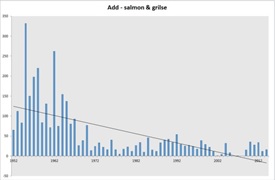
Large salmon
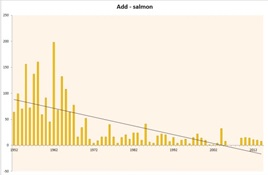
Grilse
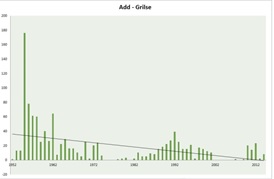
Sea trout
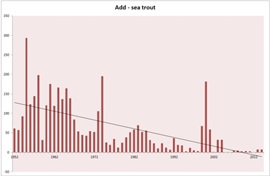
The graphs run from 1952 to 2014 and it can be clearly seen that each of the four stock components are in decline over the whole period. The River Add cannot be classed as having a good population of wild fish and this is confirmed by the categorisation of the river as Class 3 by Marine Scotland Science.
The downward trend of each of the components is clearly visible but to consider this in more detail the data was divided into two at the year 1982. This was when the then fledgling salmon farming industry first recorded a definable harvest of 1000 tonnes for all of Scotland. The data is therefore divided into the time before salmon farming arrived on the west coast and the time during which salmon farming has operated.
The following two graphs show the trend of rod catch data for total salmon and sea trout prior to the arrival of salmon farming to the west coast for the River Add. Both show a clear downward trend. These populations of salmon and sea trout were already in decline before salmon farming developed along the west coast. The continued decline of these populations was then blamed on salmon farming as a convenient scapegoat, which continues to this day. A similar picture can be found in many, but not all west coast rivers.
Total salmon catches for the River Add pre-1982
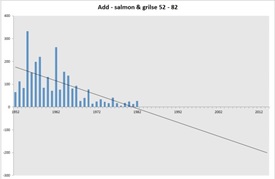
Sea trout catches for the River Add pre 1982
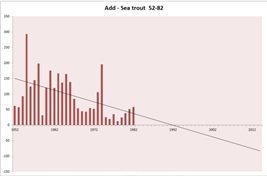
The Friends of the Sound of Jura state that salmon swim through Dounie Bay and juvenile salmon swim down the River Add but wild fish are swimming through many bays and down many rivers along the West coast including those where salmon farming operates. However, data for the whole west coast shows a positive catch trend in many of these fishery districts. In fact, 59% of the 61 west coast fishery districts show an increasing trend for at least one of the constituent stocks.
The Friends of the Sound of Jura also state that the young fish swim out of the river to use the area. This is somewhat vague and looks like a claim that has been made just to fill up the space. Do these fish specifically use this area and no other?
Finally, the Friends state that the wild fish would pick up potentially lethal infestations from the 1.1 million caged fish. Long term studies undertaken in Ireland and Norway have determined that sea lice are responsible for the deaths of two out of every hundred migrating smolts. This was measured by treating fish with an anti-lice treatment that would stop them picking up lice during the migration and then comparing them with a control group. Sea lice can be a problem for farmed salmon – not every farm suffers from sea lice – but the impact on wild fish is small.
In fact, the international fisheries organisation – ICES – say that 95 out of every 100 smolts now fail to return to breed (two of them die because of sea lice). Thirty years ago, the number was 80. These 93 smolts die at sea and such marine mortality is likely to be the main reasons why wild fish numbers are in decline. Nothing is really being done to discover how to reverse this mortality. Instead, the salmon farming industry is made the scapegoat simply because it is more visible.
There may be a weight of objections to this proposed new farm but any of these objections are based more on hearsay and rumours rather than hard facts. It seems that it is only necessary to issue a press release to the media for misinformation to be turned into the truth. The River Add is just one example of how a river depleted over many years including those before salmon farming was established, has suddenly regained a superior status in order to stand in the way of a new development. How many of the other claims are just as unjustified?
Going for a British: The BBC report that supermarket chain Waitrose is rebranding the lamb based ready meals in its ‘British’ range because some are made with lamb from New Zealand. Waitrose also have meals branded as ‘Italian’ and ‘Indian’. Farmers have objected that the inclusion of the word ‘British’ in the brand name despite the meat bring sourced from New Zealand is misleading for shoppers. They also say it is frustrating for British farmers as they could have supplied the lamb instead of it being sourced from New Zealand. Even though Waitrose have already changed the pack to say on the front that the meat is from New Zealand, the supermarket has now agreed to change the brand from ‘British’ to ‘Classic’.
This is a clear case of producers wearing blinkers and objecting about something that is of little interest to consumers. It is blatantly obvious that the packs are branded as British to reflect the style of meal rather than the contents. If this was the case, then someone should complain that the Indian meals are made with many ingredients that do not come from India. This also applies to meals branded as Italian that surely under the same train of thought, should come from Italy.
Waitrose have said that the brand was only ever supposed to denote the origin of the recipe but that they understand why the confusion arises. Yet, they are only changing the brand on the lamb dish and not on chicken or fish dishes. Under the same thought process, the fish used in the ‘Fishermens Pie’ should have been landed at a British port whereas it is labelled as being caught in the North East Atlantic. There are also cod and haddock dishes and as British, they too should have been made from fish that was landed locally, otherwise it should not be labelled as British.The reality is that most consumers look at the product name and make a decision as to whether this is what they want or not. The origin of the ingredients is of lesser importance, except clearly to the farmers.
Waitrose say that they have had a policy of buying whole carcasses from dedicated suppliers and therefore have not had sufficient raw material to make the change. Yet, at the same time British farmers should not be waiting for Waitrose to approach them. If they saw an opportunity for British lamb, then they should be actively pursuing it. Farmers can be detached from the market place and therefore are not always proactive within the market. The same can also equally apply to the fish sector.
Whilst producers might notice issues about origin, most consumers don’t. Tesco have been selling frozen Alaskan salmon for a considerable time. One of their customers posed a question on Facebook about origin and this question has escalated to the mainstream press. The shopper asked how the origin of this Alaskan salmon comes to be listed as China.
According to the Daily Mail, Tesco responded saying that the salmon is fished for in Alaskan waters but is shipped to China for cutting and packing. We have to legally display the origin on the pack where the last significant process took place. The salmon is still Alaskan. It is just where it is processed.
The Alaska Seafood Marketing Institute told the newspaper that shipping salmon to the UK via China is good for consumers and the environment. The carbon footprint is not as great as one might think. The fish could be filleted in Alaska but it would add a lot to the cost to run fillet lines for short periods. The fish are exported to China because it is the most efficient means of providing a quality product as hand filleting provides a better yield than machine filleting and this offsets the carbon dioxide footprint as more of the fish is consumed.
However, what caught our attention in the newspaper article were the comments from Ruth Westcott of Sustain, a campaign group lobbying for better food and farming, who said that common sense says we should be buying salmon locally. It is a species that a long time ago was plentiful in the waters and rivers around the UK. She said that consumers should be avoiding fish shipped across the world simply by choosing fish from closer to home.
Ruth is the campaign coordinator for Sustainable Fish Cities who is trying to encourage the consumption of only sustainable fish. Her website provides the information on alternative to those species that are not sustainable. These are listed under the top ten swaps (https://www.sustainweb.org/sustainablefishcity/top_ten_swaps/ )
The website first says why it is necessary to swap and for salmon, they say ‘salmon are sometimes farmed very intensively leading to serious environmental problems. Also farmed salmon have to be fed large quantities of feed made of wild caught fish and the fish used to make the feed can have conservation issues of its own’. (we won’t discuss our views on this statement this time – we have discussed these swaps in an issue of reLAKSation sent out a number of years ago.)
The sustainable Fish Cities website then offers a suggestion for the best alternative to what they considerable to be an unsustainable choice. Their recommendation for a top swap for salmon is stated as ‘Why not try MSC certified Alaskan wild salmon’!!!
Surely that is that same fish that she told the Daily Mail that consumers should be avoiding as it is shipped across the world. Instead, consumers should choose fish from closer to home!!


